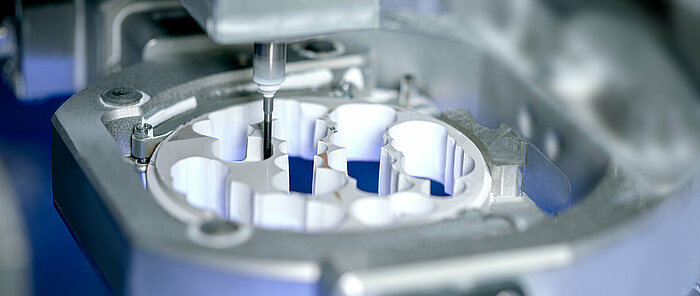Subtractive manufacturing in dental technology
Subtractive manufacturing, a process of material removal, plays a key role in modern CAD/CAM technology. This is particularly true in the dental industry, where precision and accuracy are essential. At CADdent, subtractive manufacturing is about more than just milling. It involves various processes, including grinding, all aimed at removing material from a workpiece to achieve the desired shape and fit.
The process and the technology
Central to subtractive manufacturing is the use of advanced CAM software in combination with precise milling machines and tools. Depending on the material used, these tools can be made of hardened tool steel or even be diamond-coated. CAM software is responsible for positioning in the respective material and calculates the required milling paths for the machines. It therefore creates the link between the digital design and physical production. By using various tools - from burrs to grinders - the material around the desired component is removed by the machine automatically feeding the required tools during machining based on the calculated data.
Variety of materials and their requirements
Subtractive manufacturing at CADdent is characterized by a wide range of machinable materials, including cobalt-chrome, titanium, zirconia, glass and hybrid ceramics, polymers, PEEK and wax. Each material places different demands on the manufacturing process. For example, some materials require special tooling during the milling process - such as a burrs - or water cooling to prevent overheating and ensure the quality of the end product. In short, these specific requirements of the material influence the choice of tools and techniques used in the manufacturing process.
Challenges and solutions
Despite the benefits such as smoother surfaces and lower material stresses, subtractive manufacturing faces challenges such as potential milling shadows - areas that a milling tool cannot reach – and due to the use of tools higher costs compared to other processes - such as additive manufacturing. At CADdent, these challenges are addressed through constant innovation and research in order to continuously improve the efficiency and quality of the processes.
Deepening the specific advantages of subtractive processes
Subtractive manufacturing offers significant advantages, which are particularly important in the dental sector:
Reduction of support elements:
In contrast to additive manufacturing, which usually requires several support structures, subtractive manufacturing only requires one or a few holding element(s). This simplifies the production process and minimizes the need for subsequent machining.
Smoother surface quality:
A striking feature of subtractive manufacturing is the creation of products with smooth surfaces - corresponding to the digital source data. This surface finish often reduces the need for further post-processing at various points, which saves time and costs.
Precise machining of metals without distortion and material stresses:
Another advantage is the ability for parts manufactured subtractively from metal - for example cobalt-chrome or titanium - to be subject to significantly less or no thermal expansion and therefore no stresses during the milling process. This means that they do not have to be compensated for with complex stress relief processes, as is the case with the additive process. This leads to virtually consistent product quality and therefore reduces the process risk.
Subtractive manufacturing therefore avoids almost all internal stresses in the material, which is particularly important for precise dental work such as the production of large-span bridges and bars.
Subtractive manufacturing - recommendation for abutments
Due to these specific advantages, subtractive manufacturing is particularly recommended for the fabrication of abutments, bars and precise occlusal surfaces. The high precision and surface quality achieved with this process are of decisive importance for functionality and esthetics in these areas of application.
CONCLUSION
Subtractive manufacturing is a prime example of how traditional methods and advanced technologies can work together to ensure the highest quality in dental technology. At CADdent, we combine experience-based expertise with innovative approaches to always offer our customers the best quality and service. In a rapidly evolving technological environment, subtractive manufacturing remains an integral part of our commitment to excellence and precision. It is not only a symbol of best practice, but also a testament to our willingness to break new ground and push the boundaries of what is possible, as the future will surely be an interplay of subtractive and additive technology and their combined benefits.
